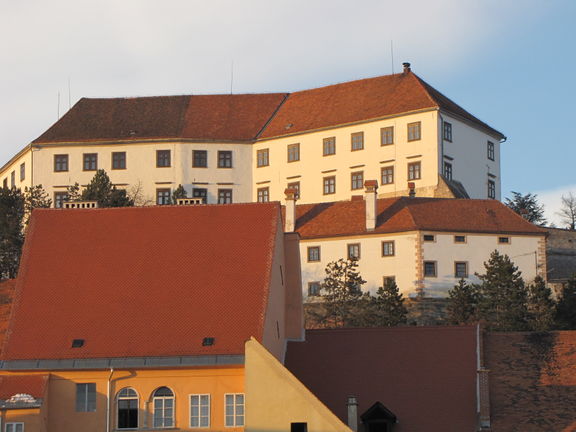Ptuj – Ormož Regional Museum
Past events
-
to
1 Jul 2011
15 Sep 2011
CroatiaPulaAmphitheater Gallery of the Archaeological Museum of IstriaWith a Fibula into Fable exhibition organised by Koper Regional Museum, Sergej Mašera Maritime Museum, Goriška Museum, Tolmin Museum, Ptuj – Ormož Regional Museum, and Notranjska Museum, Postojna
History
The first museum in Ptuj was the open-air Povoden Museum, created in 1830 by curator Simon Povoden. However, the origins of Ptuj Regional Museum can be traced back to the Museum Society, established in 1893 by members of the Tourist Society of Ptuj with the aim of preventing the transfer of valuable excavated archaeological material from Ptuj to Graz or Vienna. The Museum Society's first collection, stored in the premises of the grammar school in Ptuj's present-day Prešernova Street, originally comprised only archaeological objects, but in 1895 Professor Franz Ferk donated his extensive private collection, consisting of museum objects of various types. As a result of this valuable donation, the museum was renamed the Municipal Ferk Museum. The museum's collections were cramped in the grammar school, so in 1926 the Municipality of Ptuj bought the former Dominican Monastery which had been dissolved by Joseph II's reforms of 1786. The premises were renovated and two years later they were occupied by the museum's collections.
In 1945 the museum was entrusted with the management of the Ptuj Castle complex of buildings, in which the furnishings of the castle's last owners – the Herbersteins – had been preserved almost completely. The library and archives became independent institutions in 1954 and 1955 respectively, while the museum extended the geographical scope of its activities and was renamed the Regional Museum Ptuj in 1963. Today the museum covers the wider area of Ptuj and Ormož and is officially known as the Ptuj – Ormož Regional Museum.
European Capital of Culture 2012
As the partner city of Maribor, European Capital of Culture, the museum opened the renovated former castle horse stables as a new venue for its rich collection of the Shrovetide carnival masks from the Ptuj region, and hosted the fourth International Congress of the International Lychnological Association Ex Oriente Lux in cooperation with the Gorenjska Museum and the Municipality of Ptuj.
Programme and activities
The Ptuj – Ormož Regional Museum preserves and displays various archaeological, historical, cultural and ethnological collections and other services. Permanent collections can be seen in Ptuj and Ormož and their nearby surroundings.
In the scope of the main unit, there are three workshops which protect and restore items belonging to the cultural heritage, as well as survey climatic conditions in the museum. The Textile Workshop has long been the only workshop of its kind in Slovenia, capable of mending fragile fabrics. In the 1980s, the Textile Workshop started to work on precious tapestries kept in the museum. The Metal Workshop takes care of archaeological evidence, artefacts, weapons and armours, while another workshop deals with wooden furniture, artefacts and works of art made of wood. Priority is given to the local museum items, although from time to time the workshops work on items belonging to private or other public institutions collections.
Collections
The permanent collection installed at Ptuj Castle and the adjacent former horse stables incorporates exhibitions on feudal dwelling culture, arms, musical instruments, glass paintings, the Shrovetide masks and the France Mihelič graphics collection. Works of international significance displayed here include the world-famous statues of St Barbara and St Katarina (1410) from Velika Nedelja Castle, which belong to the group of sculptural works from the 'Ptujska gora workshop', which created several masterpieces in the International Gothic style; the Brussels (scenes from the Odyssey) and French (Verdure) tapestries of the early and late 17th century respectively; and the famous Turqueries paintings commissioned by Johann Josef Herberstein after his return from a diplomatic mission to Constantinople in 1666. The museum holds also the biggest musical instruments collection in Slovenia.
The Old Prisons building was renovated in the 2000s and hosts the Ptuj and its Surroundings in the 20th Century permanent exhibition.
In 1899 and 1914, the sites of Mithras Shrine I in Spodnja Hajdina and Mithras Shrine III in Zgornji Breg, respectively, were arranged for presentation. By 1987 archaeologists had discovered evidence of five Mithras Shrines; however Mithras Shrines I and III are still the favourites with visitors.
Venues and branches
The Ptuj – Ormož Regional Museum also manages two galleries – Mihelič Gallery and Salon of Art, as well as numerous cultural heritage sites, including the Ptuj Castle (in which the museum is located), the Povoden Museum, Ptuj, the Old Prisons, Mithras Shrine I in Spodnja Hajdina, Mithras Shrine III in Zgornji Breg, and the Roman Brickworks Kiln, Ptuj. The other related monuments in the region are: Orpheus Monument, Ptuj and Velika Nedelja Castle.
See also
Branches, monuments and sites
- Ptuj – Ormož Regional Museum, Ormož unit
- Velika Nedelja Castle
- Mithras Shrine I in Spodnja Hajdina
- Mithras Shrine III in Zgornji Breg
- Orpheus Monument, Ptuj
- Povoden Museum, Ptuj
- Roman Brickworks Kiln, Ptuj
